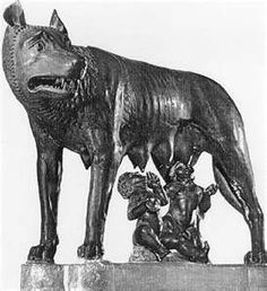
~ John O'Donohue
What do a she-wolf, a sacred cave, a goat, and the mating season of birds have to do with a holiday now associated with roses, chocolates, and frilly red hearts?
I grew up in a household skeptical of Hallmark holidays and the kind of forced sentimentality that's often a greater expression of commercial consumerism than any deeply inherited meaning.
But Hallmark is only one in the long line of forces that has channeled ancient rites and rituals into modern mores. The Christian Church grafted its holidays onto any number of pagan celebrations in an effort to coopt the rhythms of nature-based rites that had created meaning and strengthened communities for countless centuries.
Lupercalia, for instance: a sacred festival held in the middle of February to connect Romans to their origin story and to Faunus, their god of forest and fields. You could hardly get more nature-based than Rome's founders, Romulus and Remus, who were suckled as infants by a she-wolf, a lupa. An order of priests called the Luperci would gather at the cave thought to be the site of this early day-care center. According to History.com:
The priests would sacrifice a goat, for fertility, and a dog, for purification. They would then strip the goat’s hide into strips, dip them into the sacrificial blood and take to the streets, gently slapping both women and crop fields with the goat hide. Far from being fearful, Roman women welcomed the touch of the hides because it was believed to make them more fertile in the coming year. Later in the day, according to legend, all the young women in the city would place their names in a big urn. The city’s bachelors would each choose a name and become paired for the year with his chosen woman. These matches often ended in marriage.
At the end of the 5th century AD Pope Gelasius outlawed Lupercalia as sacrilegious and replaced it with St. Valentine’s Day. (No one knows exactly who Valentine was; there are at least three martyred saints by that name.)
It just so happens that the day chosen by the Catholic Church to honor St. Valentine's was the same day known by many in the Middle Ages as the start of birds' mating season. It's not surprising that these longer days of February have been heralded by fertility rituals throughout the ages.
We know so little about the ground our ancestors stood on, the traditions that sustained them and connected them to the seen and unseen worlds around them. But occasionally we get a sense, a stirring in the season - in our cells, even - of the thin line that connects our lives to theirs.




 RSS Feed
RSS Feed